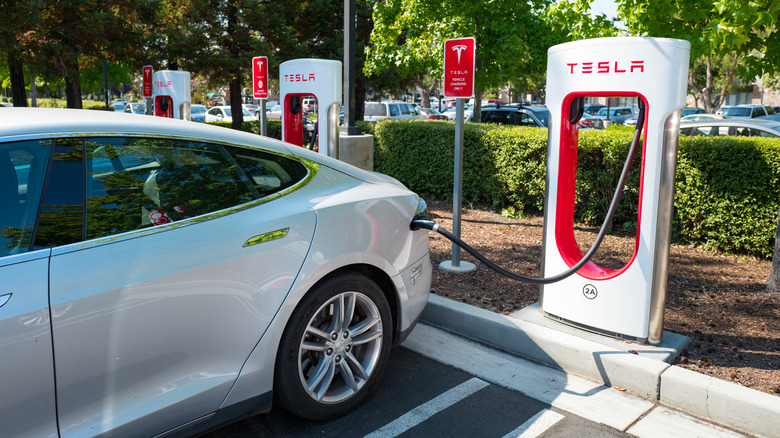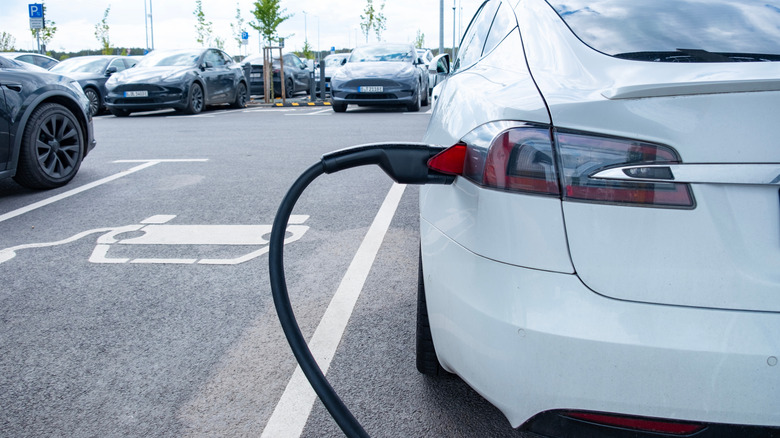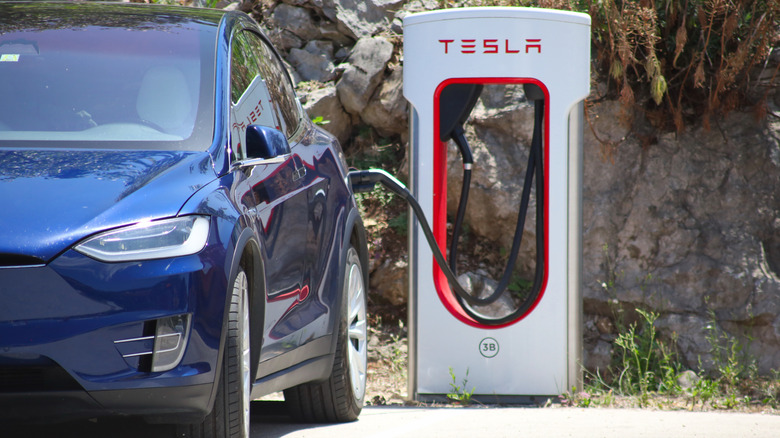What Happens If A Tesla Battery Drains To Zero? (And Would It Be Bad For Its Health?)
Just like the batteries fitted inside your daily-use gadgets such as phones and computers, the massive packs kitted inside Tesla's electric cars are perishable. They undergo an electrochemical charge-discharge cycle that slowly eats away at their capacity to hold charge (aka battery health), and eventually, you need to get a replacement. There are a few tactics to slow down the damage incurred by the regular cycle and enhance the longevity of batteries inside electric cars. One of those measures is avoiding a 0% charge, or a situation where the battery is completely drained and you aren't left with any reserve power either.
But what happens when your Tesla's battery pack is completely drained, and does it take a toll on the health of your car's battery? "Never allow the Battery to fully discharge," Tesla bluntly notes on its user guide, adding that it can damage car components. The carmaker adds that when the charge level drops close to 0%, the entire system enters a low-power mode, where it stops supplying power to the onboard electronics and the secondary low-voltage battery.
At this stage, the low-voltage auxiliary battery takes over to handle core functionalities such as opening the door and unlocking the car. Tesla suggests that you must immediately charge the car at this point. Once this secondary battery is also discharged, there is no other option left but to manually jumpstart it. Once that is done, core functionalities are restored, and you can plug in a charger to top up the main battery.
The recovery plan
Tesla warns users that they should not live with the misplaced notion of a reserve range or electric power, once they see their car flashing the 0% or a zero miles warning sign. The company adds that once the main battery runs out of juice, the low-voltage battery is no longer technically supported. In such scenarios, you have to first jump-start the low-voltage battery before the car can be plugged into a charger. During the process, users are advised to connect it with an external power source for only 20 seconds. Tesla also warns that you must be very careful as there are risks of a short circuit.
"Damage to the low voltage battery due to running out of range is not covered by the warranty," warns Tesla. The best way forward is to avoid fully emptying the main battery pack. In case you run into that inevitable scenario, park the car on the side and call for a towing service, and take the car to a charging station. If the car's internal systems are non-responsive, a jump start is mandatory. Next, wait for the touch screen panel to come to life, and only then plug the charger to juice up the main battery pack.
Tesla tells car owners to ensure that there is enough range left in the tank before they park their car for extended storage. Moreover, factors such as temperature, driving habits, wind resistance, and in-car vehicle settings can reduce the actual range compared to the projected value you see in the mobile app or the car's dashboard.
Understanding the risks
The folks over at CarMax drove a Tesla EV to the 0% battery level after seeing repeated warnings. The car first goes into a slow-paced "turtle mode," and the power steering and power brakes stop working. Despite seeing the 0% range warning, the test car was able to go an extra 15 miles, a reserve range, so that you can find a charging point nearby. "You can't bank on that reserve charge giving you a certain number of miles," warns the test driver. This is also bad news for battery health, says Kia.
According to a research paper published in the Renewable and Sustainable Energy Reviews journal, over-discharge poses a variety of systemic damage risks. "Over-discharge can also result in catastrophic internal short circuit, as well as SEI failure and the generation of gas," it says. Another paper published in the Nature journal mentions capacity degradation and internal short circuit as the after-effects of over-discharging large-format lithium-ion batteries, the kind you will find inside cars like those sold by Tesla.
Recurrent, a startup that offers software to analyze the battery health of used electric cars, explains that the auxiliary 12V battery in EVs handles accessories and security features when a car is parked, such as the central lock, alarm, diagnostics, and monitoring of the main battery pack. It is trickle-charged by the main battery, but completely draining the batteries comes with tangible risks. In 2012, reports claimed that fully draining the battery pack on a Roadster kills the battery, even though Tesla downplayed the concerns.


